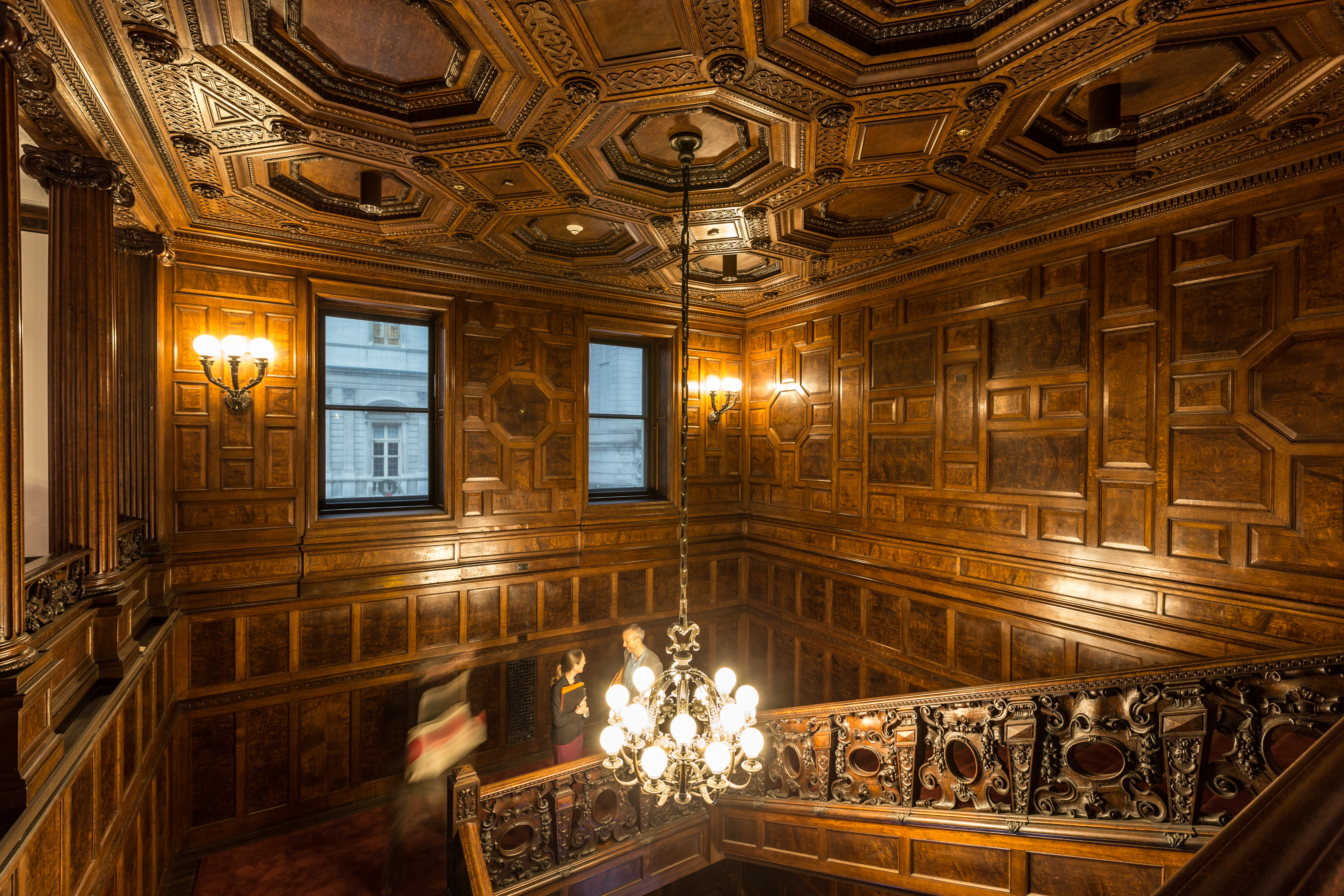Table Of Content

Active primarily in Paris, France, Sonia Delaunay (Ukrainian, 1885–1979) was a modern artist and designer who merged art and everyday life. Along with her husband Robert Delaunay, she developed a theory for the vibration of contrasting colors when they are placed side by side. In 1996, Rebeca Méndez (Mexican-American, born 1962) opened her eponymous studio, specializing in film and video installations for cultural programs and institutions, collaborations with architects on interior commissions, photography, book design, and public art. Her practice embodies experimentation, collaboration, and creative integrity. All this technology, supported and complemented by the Cooper Hewitt's new website and digital collections, affords a deeper understanding and appreciation of the more than 200,000 objects in the museum's collection. But the greatest object in the collection is the building, and it is best understood and appreciated simply by visiting.

Preview the New Cooper Hewitt Experience
It's beautiful and hypnotic and fun to guess what kind of object will be revealed as you drag a circle to the center of the screen as it expands into a full high-resolution image. Cooper Hewitt aims to create provocative dialogues around design and amplify its historical continuum. A year-round program of lectures, conversations, and hands-on workshops provide access to the world’s leading design minds and engages design lovers of all ages in the design process. The museum’s annual National Design Awards is its largest and most visible education initiative. Honoring excellence, innovation, and lasting achievements in American design, the Awards are bestowed every fall at a gala dinner and ceremony in the museum’s Arthur Ross Terrace and Garden during National Design Week. Held in conjunction with the Awards, National Design Week celebrates design’s impact on all aspects of daily life.
Creative Curriculum
After a presentation of his work, Yu joins in conversation with Matilda McQuaid, Acting Director of Curatorial. Launched in 2006, National Design Week is held in conjunction with the National Design Awards. This week-long series celebrates the important role design plays in all aspects of everyday life and features a range of in-person and virtual programs for all ages. Cooper Hewitt, Smithsonian Design Museum is housed in the former home of industrial magnate Andrew Carnegie. Learn about the history of the mansion and its transformation from home to museum.
Collection
In October 2023, Cooper Hewitt celebrated National Design Week with free admission and special programming. We encourage you to limit the number of personal belongings and bags you bring into our facilities. Please wash and sanitize hands frequently during your visit and practice good hygiene. We are asking all visitors who are sick or feel unwell to please stay home. On Thursday, May 2, Cooper Hewitt will be closed to the public from 10 a.m.
In 2008, the museum launched a new effort to renovate and expand the building. In 1895, Peter Cooper's granddaughters, Eleanor Garnier Hewitt, Sarah Cooper Hewitt, and Amy Hewitt Green, asked the trustees of the Cooper Union for room in which to install a Museum for the Arts of Decoration, modeled after the Musée des Artes Décoratifs of Paris, France. The purpose of the museum was to provide the art students of Cooper Union, other students of design, and working designers with study collections of the decorative arts. The trustees assigned the fourth floor of the Cooper Union's Foundation Building to the sisters, and the museum was opened to the public in 1897. The Cooper Hewitt, Smithsonian Design Museum, located in New York City, is the only museum in the nation devoted exclusively to historic and contemporary design.
The Immersion Room on the second floor uses digital and projection technologies to bring the museum’s collection of wallcoverings, the largest and most significant in North America to life. Browse hundreds of high-resolution digitized wallpapers and see them projected at full-scale, floor-to-ceiling on the surrounding walls. Sketch your own designs, adjust the colors and manipulate repeat patterns, and see them projected on the walls around you. Selected wallcoverings are accompanied by brief audio commentary with designers, who share design insights and inspiration.
A New Es Devlin Exhibition Reveals the Humble Beginnings of Her Maximalist Visions - artnet News
A New Es Devlin Exhibition Reveals the Humble Beginnings of Her Maximalist Visions.
Posted: Mon, 27 Nov 2023 08:00:00 GMT [source]
VISITOR GUIDE

At the end of the hall, where the Carnegies once slept, The Hewitt Sisters Collect tells the story of Sarah and Eleanor and the early days of the museum now known as Cooper Hewitt. Inspired by Paris's Musée des Arts Décoratifs and London's Victoria & Albert Museum, the sisters sought to elevate the status of the decorative arts in America, and traveled across Europe collecting examples of exceptional artistic or technical merit to bring back for exhibition. From block prints to birdcages, the collection was eclectic from the start, embracing almost everything as design and establishing a method for a museum that today exhibits a 3D-printed prosthetic limb next to Abraham Lincoln's pocket watch.
Textile Design
Another screen on the second floor reveals the history of the Carnegie Mansion before it became the Cooper Hewitt. You can navigate the Mansion History application using the original floor plan of the building and browse through architectural details, original fittings and fixtures, and the quirks of the mansion’s original residents. The Lab is a free, interactive platform for discovering millions of authentic digital resources for your virtual or physical classroom.
Process Lab
An Atlas of Es Devlin is the first monographic museum exhibition dedicated to British artist and stage designer Es Devlin (born 1971), who is renowned for work that transforms audiences. Since beginning in small theaters in 1995, she has charted a course from kinetic stage designs at the National Theatre and the Metropolitan Opera to installations at major institutions including the World Expo, Lincoln Center, and the United Nations headquarters. Her sculptures for Olympic Ceremonies, NFL Super Bowl halftime shows, and stadium tours for Beyoncé, The Weeknd, and U2 frame narratives that feel personal at a monumental scale. Over the past decade, she has adapted her craft to address climate and civilizational crises.
When an image is selected, the table works as a virtual gallery wall, displaying catalog information and historical data, with the added digital benefit of category and color tags. Like the wall texts, you can also touch The Pen to the table to save the vase to your collection for later reference. You can explore the museum’s offerings by randomly drawing lines or shapes on the surface and letting the computer bring up an object that corresponds to your scribbling.
Her public installations on endangered species and languages have inspired audiences to reimagine their connections to each other and to the planet. Cooper Hewitt is the nation’s only museum dedicated to historic and contemporary design, with a collection of over 210,000 design objects spanning thirty centuries. Located in the landmark Andrew Carnegie mansion and boasting a beautiful public garden, Cooper Hewitt makes design come alive with unique temporary exhibitions and installations of the permanent collection. The recent renovation of the museum, its enclosed garden, and two adjoining townhouses merged state-of-the-art restoration and conservation of the campus with bold reimaginings of exhibitions and gallery spaces, visitor experiences, and creative technologies. The result is a museum that stands as a new paradigm for design thinking and problem-solving. The museum was renamed the Cooper-Hewitt Museum of Design at the time of the transfer, and became the Cooper-Hewitt Museum of Decorative Arts and Design in 1969.
Visit our Getting Here page for more information on public transportation and parking near the museum. For accessible entrance, please inquire with staff at the 2 East 91st Street entrance. The mansion was designed by the architectural firm of Babb, Cook & Willard in the style of a Georgian country house. Another innovation was the inclusion of both central heating and a precursor to air-conditioning. In the cellar, enormous twin boilers were run by coal transferred from storage bin to furnace by a coal car that traveled over a miniature railroad track. The museum changed its name to Cooper Hewitt, Smithsonian Design Museum in 2014.
A chronicle of the lives and contributions of the sisters and how they created The Cooper Union Museum for the Arts of Decoration. Ilonka Karasz (Hungarian, 1896–1981) studied art at the Royal Academy of Arts and Crafts in Budapest, where she was one of the first women to be admitted. After immigrating to the United States in 1913, she became an active member of the New York design scene. Working in a variety of mediums, Karasz is well known for her wall coverings and illustrations. Trained at the Kansas City Art Institute, April Greiman (American, born 1948) continued her studies at the Kunstgewerbeschule in Basel, Switzerland.
Strangely, the streamlined modern tables don't seem too out of place in even the most ornate spaces because everywhere you look there is a pleasing blend of the old with the new. Cooper Hewitt, Smithsonian Design Museum is the nation’s only museum dedicated exclusively to historic and contemporary design, with a collection of more than 215,000 design objects spanning 30 centuries. From ancient textiles and works on paper to icons of modern design and cutting-edge technologies, Cooper Hewitt’s collection serves as inspiration for creative work of all kinds and tells the story of design’s paramount importance in improving our world. Cooper Hewitt is the only museum in the United States devoted exclusively to historical and contemporary design, and is the steward of one of the most diverse and comprehensive design collections in existence—more than 215,000 design objects spanning 30 centuries.
Greiman was then appointed to Director of the California Institute of the Arts in 1982 where she had the opportunity to work with photographer Jayme Odgers to experiment with video and computers. Greiman’s approach to design is to look at the page as a three-dimensional space through the juxtaposition of typography, photography, and other elements. April Greiman (American, born 1948) trained at Kansas City Art Institute from 1966 to 1970 and continued her postgraduate studies with Wolfgang Weingart and Armin Hoffman at the Kunstgewerbeschule in Basel, Switzerland, from 1970 to 1971. Greiman became an instructor at Philadelphia College of Art and worked in both Philadelphia, Pennsylvania, and New York City. Guest curator Rebeca Méndez considers how culture, design, technology, and the natural world have converged throughout history. From the 1890s to the 1920s, Sophia Crownfield designed prints for prominent silk and wallpaper firms in the United States.

No comments:
Post a Comment